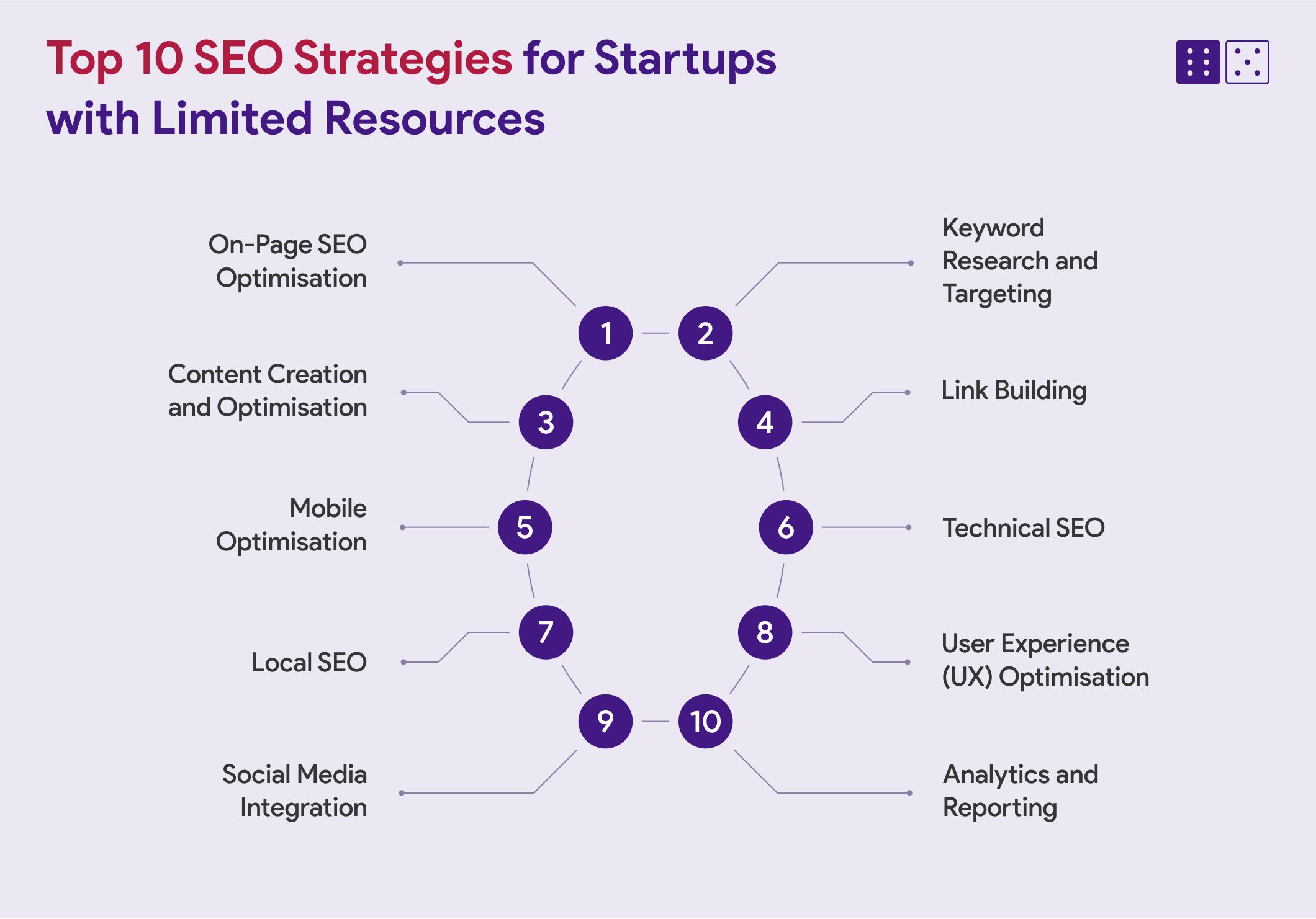Top 10 SEO Strategies for Startups with Limited Resources
Companies known to use, sell, or share user data to train AI models Companies known to use, sell.

SEO is essential for startups who want to create an online presence on a shoestring with minimum funding. Good SEO may increase conversion rates, increase brand visibility, and generate organic visitors.
This article explores ten cutting-edge SEO tactics designed for resource-constrained companies, offering a technical road map for optimizing your online presence.

Doing keyword research is essential to succeeding with SEO. Selecting the appropriate keywords will increase rankings, drive focused traffic, and help you understand user intent.
According to Neil Patel’s blog, “You can use keyword research to discover universal, national, or global topics that people are searching.. But you can also use local keyword research to find topics that only people in a specific area are searching for. This means you can do keyword research even if you are a small business that only serves customers in a particular city or state.”
SEO was employed by ethical apparel company Everlane to advance sustainability and openness in the industry. They used targeted keywords like “sustainable fashion” and “ethical clothing” to optimise the product descriptions.

A glimpse into Everlane’s website
Let’s look at another example from the beauty firm Glossier, which has gained widespread recognition. “Into The Gloss” provides comprehensive beauty tips covering everything from makeup application methods to skincare regimens.
We meticulously optimise each guide for search engines. Glossier finds popular search terms for skincare and cosmetics by doing in-depth keyword research.
Following that, these keywords are organically included into the headings, meta descriptions, and content. By doing this, you can be sure that the instructions will appear prominently on search engine results pages (SERPs), which will bring in natural traffic to the website.
Utilise free tools such as Google’s Keyword Planner, Ubersuggest, and AnswerThePublic to identify relevant keywords with high search volume and less competition. For more deeper insights, consider leveraging low-cost and affordable tools like Semrush or Ahrefs on a limited basis.
Pay attention to long-tail keywords, which are more elaborate and targeted sentences. Because these terms are more specialized and face less competition, they typically have lower search volumes but better conversion rates.
Make sure your meta titles and descriptions are optimized using your main keywords. Enhancing click-through rates (CTR) and search engine rankings requires these components.
H1, H2, and H3 header tags are used to organize content in a hierarchical manner. Make sure your main keywords appear organically in these tags to improve both SEO and readability.
As rightly pointed out by Forbes Advisor, “Google typically scans your page for relevant information, and that’s far easier for it to do when you have the page organised with clear headers.”
Internal links help distribute page authority and create a logical site structure. This improves user navigation and ensures that search engines can index your content more effectively.
Quoting Forbes Advisor again, “Google is also looking for authoritative content, and you can show what you’ve written about is worthwhile by linking to authoritative external links—links to pages outside your site. For example, linking to a government website can boost your site’s credibility.”
Create high-quality, valuable content that addresses the needs and interests of your target audience. Quality content is more likely to attract backlinks and social shares, boosting SEO performance.
Drift, a startup providing conversational marketing and sales technology, successfully implemented SEO strategies to grow its user base. Their podcast, “Seeking Wisdom,” provided valuable insights and built authority in the industry, generating organic backlinks and traffic.

A glimpse into Drift’s podcasts
1,500 words or more of long-form material typically score higher in search results. Make sure the article offers in-depth information and is thorough and well-researched.
To prevent keyword stuffing, keep your keyword density between one and two percent. Incorporate keywords organically into the material, and to improve relevancy, think about adding LSI (Latent Semantic Indexing) keywords.
In the words of Content Whale, “LSI keywords enhance the relevance and quality of content by providing a broader context for search engines.”
The source also says, “Instead of relying solely on exact keyword matches, latent semantic indexing in SEO helps search engines understand the thematic connections between words.”
Since a large amount of online traffic originates from mobile devices, make sure your website is optimized for mobile devices. Make use of responsive design strategies to offer a consistent user experience on all platforms.
Reduce the amount of JavaScript, use browser caching, and compress pictures to maximize the speed at which pages load. Search engines like and enhance user experience on pages that load quickly.
Claim and optimise your Google My Business (GMB) listing. Provide accurate business information, add high-quality images, and encourage customer reviews to enhance local search visibility.
Le Poulbot is a French restaurant, that has very sophisticatedly built its Google My Business page to drive traffic to its website and explore its various food and dining options. They have used high-quality images and utilised the reviews section well to build a standing for themselves.

A glimpse into Le Poulbot’s menu
Ensure consistent business information across all online directories and local citations. This consistency helps build trust and improves local search rankings.
Create content tailored to local audiences. Incorporate local keywords and address region-specific topics to attract local traffic and improve local SEO.
According to Semrush, “Local SEO keyword research is the process of finding keywords people search for when looking for products, services, or amenities in their areas. Which tells you exactly what potential customers are searching for. If you rely on local businesses, that’s valuable information.”
Concentrate on obtaining reputable websites to link to you with high-quality backlinks. Search engine rankings and domain authority can both be enhanced by backlinks.
Participate in guest posting on websites for related industries. This establishes you as an authority in your niche and gives you backlinks.
Find broken links on reliable websites, then provide your material as a substitute. This tactic aids in boosting SEO and obtaining high-quality backlinks.
Make an XML sitemap and submit it to search engines. This makes it easier for search engines to index your pages and comprehend the structure of your website.
To manage the way search engines index your website, use the robots.txt file. Make sure the relevant pages can be indexed and crawled.
Implement structured data (schema markup) to help search engines understand your content better. This can enhance search visibility through rich snippets and improved indexing.
Ensure your website has intuitive and user-friendly navigation. A well-organised website improves user experience and promotes more in-depth visits, both of which are beneficial to SEO.
Use bullet points, subheadings, and brief paragraphs to make your text easier to read. User engagement and retention are improved by legible and clear information.
Use attention-grabbing CTAs to nudge users in the direction of the desired activities. Conversion rates and the user experience can both be enhanced by effective CTAs.
Use Google Analytics to track user behavior and website performance. To find areas that need work, examine metrics like session duration, bounce rate, and conversion rates.
Leverage Google Search Console to track search performance, identify indexing issues, and optimise your site for better search visibility.
Conduct regular SEO audits to identify and rectify issues. Tools like Screaming Frog and Ahrefs can help in auditing your site’s SEO health.
Social signals can increase the reach and traffic of content, even though they are not direct ranking considerations. Actively participate on social networking sites to market your material and draw in natural backlinks.
To encourage users to share your material with their networks, include social sharing buttons in it. Growing social media shares might help SEO inadvertently by increasing traffic and building backlinks.
As WinSavvy rightly puts it, “The location of your social sharing buttons can impact their effectiveness. Test different locations on your page to see which one results in the most shares. Common locations include at the top of the article, at the bottom, or a floating sidebar that follows the user as they scroll down the page.”
Ensure that your branding is consistent on all social media platforms. By increasing user engagement and brand loyalty, this indirectly supports SEO efforts by fostering a sense of trust and recognition.
Despite starting with a tiny marketing budget, Glossier used creative SEO strategies to build its brand. By working with micro-influencers who were well-known online, Glossier was able to expand its following organically.

A glimpse into Glossier’s current storefront
SEO is a complex and continuous process, particularly for new businesses with little funding. You can improve your website’s exposure, attract organic visitors, and experience long-term growth by deliberately concentrating on the previously mentioned categories. Recall that consistency, ongoing education, and adaptation to the rapidly evolving digital landscape are essential components of successful SEO.
As Ahrefs explains, “As with many things in life, the beginning is always the hardest. It may take some time to get your SEO up and running. But once you do so, you can use the same tactics over and over again for consistent results that have compounding effects.”
By strategically focusing on keyword research, content creation, on-page optimization, technical SEO, link building, and local SEO, startups can significantly enhance their website’s visibility and drive organic traffic.
Again, acing the SEO game is not rocket science for startups with limited resources. This can be done with consistency and adopting methodologies explained in this article.
Share
By clicking “Subscribe” you agree to ELEVEN DICE Privacy Policy and consent to ELEVEN DICE using your contact data for newsletter purposes
In the cutthroat world of digital marketing, producing quality leads is essential for business expansion for all types of enterprises. One of the most important tactics for drawing in, interacting with, and winning over new clients is content marketing. This article explores the sophisticated techniques for using content marketing to produce high-quality leads. It focuses […]
Imagine you’re browsing social media and you come across a post or an ad of some celebrities wearing stylish sunglasses from a brand you haven’t heard of before. It is possible that you will search the brand online and discover their website. You may go through their collection, be impressed by the variety and unique […]
In today’s very competitive landscape of SaaS (or Software as a Service), effective marketing tends to be very crucial. One of the most impactful and cost-effective marketing strategies for SaaS companies is, undoubtedly, Search Engine Optimization (or SEO, as we know it). By understanding and implementing SEO, SaaS businesses can not only increase their digital/online […]
Writing tips and examples, best reads, cool tools, jobs, and friendly encouragement to do your best writing. sent weekly, on Thursdays.
Sent weekly, on Thursdays. Costs $0. Unsubscribe any time.
